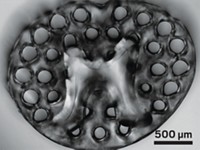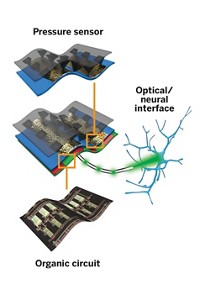Advertisement
Grab your lab coat. Let's get started
Welcome!
Welcome!
Create an account below to get 6 C&EN articles per month, receive newsletters and more - all free.
It seems this is your first time logging in online. Please enter the following information to continue.
As an ACS member you automatically get access to this site. All we need is few more details to create your reading experience.
Not you? Sign in with a different account.
Not you? Sign in with a different account.
ERROR 1
ERROR 1
ERROR 2
ERROR 2
ERROR 2
ERROR 2
ERROR 2
Password and Confirm password must match.
If you have an ACS member number, please enter it here so we can link this account to your membership. (optional)
ERROR 2
ACS values your privacy. By submitting your information, you are gaining access to C&EN and subscribing to our weekly newsletter. We use the information you provide to make your reading experience better, and we will never sell your data to third party members.
Materials
Wireless, Biodegradable Sensors Monitor Brain Pressure
Materials: Devices could improve care available to victims of gunshots, car accidents, and other traumatic head injuries
by Matt Davenport
January 19, 2016
| A version of this story appeared in
Volume 94, Issue 4

A 30-member research team that includes chemists, engineers, and medical doctors has unveiled implantable wireless sensors that biodegrade within the body (Nature 2016, DOI: 10.1038/nature16492). Such sensors could help doctors better monitor brain pressure, which is critical during care for severe head trauma caused by gunshots, car crashes, and other injuries, the team says.

Doctors can already monitor brain pressure with implantable sensors that don’t degrade, but the new devices, which disappear after several days, offer several advantages, says team member Rory Murphy of Washington University School of Medicine. “Because they dissolve, we don’t have to go back in and get them,” he explains. “Nobody wants a second surgery.”
Furthermore, existing sensors connect to monitors outside the patient using rather bulky wires that can easily become dislodged, Murphy says. Larger wires also present heightened opportunities for infection.
Two new sensor platforms—developed by John A. Rogers and his team at the University of Illinois, Urbana-Champaign—could alleviate these concerns. The team demonstrated the potential of these devices by implanting the sensors in and on the brains of rats.
The first platform uses extremely thin molybdenum wires to connect a completely degradable sensor to a small wireless transmitter on top of a rodent’s head. “Unlike anything that exists today, this electronic system completely breaks down into biocompatible materials,” Rogers says of the sensor implanted inside a rodent’s intercranial space.
The second platform is completely implantable, but only 85% degradable, Rogers says. The sensing elements still dissolve, but some circuitry for wireless data transmission remains.
Still, Rogers adds, the permanent components are small enough that this design would likely be a viable approach for human patients, even as the group works toward a device that is entirely implantable and biodegradable.
Both platforms rely on sensors with layered architectures, starting with a thin, flexible substrate, such as porous silicon. The team coats the substrate with a layer of poly(lactic-co-glycolic acid), a biodegradable polymer, to trap an air pocket in the device. The polymer acts like a drumhead and moves in response to changes in the pressure of the fluid surrounding the brain
The next layer is made from a silicon nanomembrane. When the drumhead polymer moves, it strains the membrane and changes its electrical resistance, allowing the team to convert pressure fluctuations into electronic read-outs.
Finally, the entire assembly is encased within poly(lactic-co-glycolic acid). The thickness of this coating determines how long the device will last in the rodent before dissolving, a timespan ranging from hours to days. The team adds that the sensors could be modified to measure different quantities, such as temperature, and implanted in different parts of the body.
These devices are impressive, says Zhenan Bao, whose team is developing wireless and biodegrable medical sensors at Stanford University. “With more materials and device fabrication developments, I believe there will be more and more such electronics devices available in the next few years,” she says.
Rogers agrees that advanced materials will move the field forward. “This is all driven by new materials and chemistry,” he says.





Join the conversation
Contact the reporter
Submit a Letter to the Editor for publication
Engage with us on Twitter